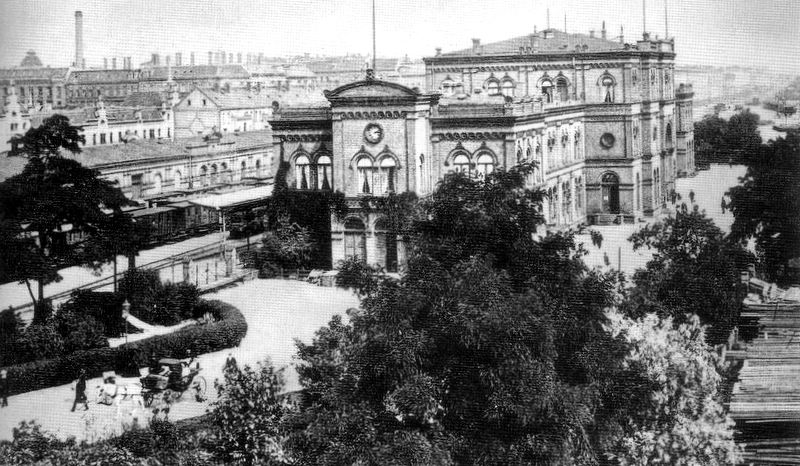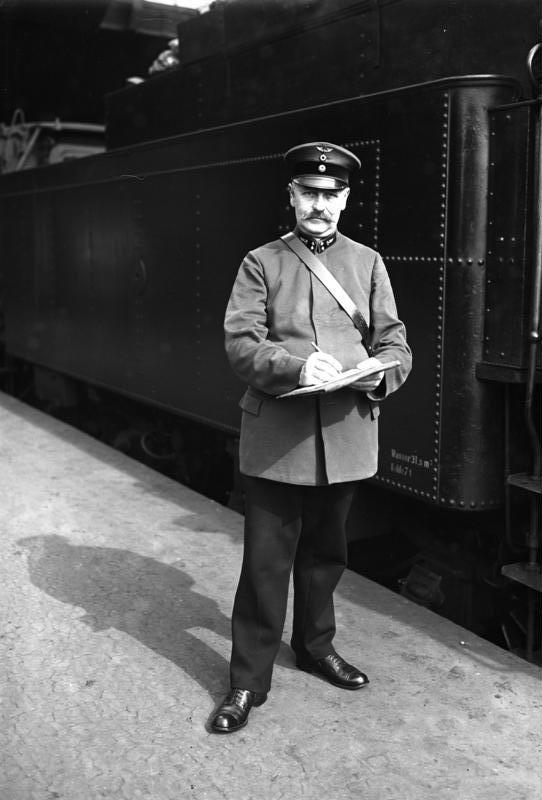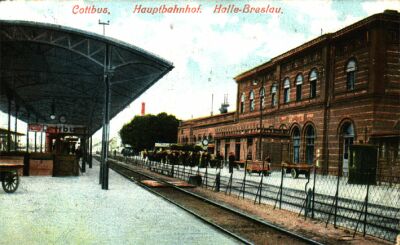|
Leipzig–Eilenburg Railway
The Leipzig–Eilenburg railway is a two-track, electrified mainline railway in the German state of Saxony, originally built and operated by the Halle-Sorau-Guben Railway Company (german: Halle-Sorau-Gubener Eisenbahn-Gesellschaft) as the Eilenburg Railway (''Eilenburger Eisenbahn''). It runs from Leipzig to Eilenburg and is part of the long-distance connection from Leipzig to Cottbus. History The line branches off in Eilenburg from the Halle–Cottbus railway, which was built in 1872. The line runs via Jesewitz and Taucha to Leipzig and is 23.6 km long. On 1 November 1874, the route was opened as a connection to the Leipzig–Dresden railway. In Leipzig, it terminated at the Eilenburger Bahnhof (Eilenburg station), which at that time was on the eastern outskirts of the city. In 1884, the line, along with rest of the Hall-Sorau-Guben Railway, was nationalised and became part of the Prussian state railways and on 1 April 1920 it was absorbed into Deutsche Reich ... [...More Info...] [...Related Items...] OR: [Wikipedia] [Google] [Baidu] |
15 KV AC Railway Electrification
Railway electrification systems using at are used on transport railways in Germany, Austria, Switzerland, Sweden, and Norway. The high voltage enables high power transmission with the lower frequency reducing the losses of the traction motors that were available at the beginning of the 20th century. Railway electrification in late 20th century tends to use AC systems which has become the preferred standard for new railway electrifications but extensions of the existing networks are not completely unlikely. In particular, the Gotthard Base Tunnel (opened on 1 June 2016) still uses 15 kV, 16.7 Hz electrification. Due to high conversion costs, it is unlikely that existing systems will be converted to despite the fact that this would reduce the weight of the on-board step-down transformers to one third that of the present devices. History The first electrified railways used series-wound DC motors, first at 600 V and then 1,500 V. Areas with 3 k ... [...More Info...] [...Related Items...] OR: [Wikipedia] [Google] [Baidu] |
Jesewitz
Jesewitz is a municipality in the district of Nordsachsen, in Saxony, Germany. The area of Jesewitz is 52.27 km² with a population of 3,090 (as of December 31, 2020). Geography and transportation Jesewitz district is approximately 15 kilometers north-east of Leipzig and 5 kilometers south-west of Eilenburg. The national roads B107 and B87 and the Leipzig–Cottbus railway pass through the district. The district is bordered by the town of Taucha to the west and to the east by the Mulde The Mulde () is a river in Saxony and Saxony-Anhalt, Germany. It is a left tributary of the Elbe and is long. The river is formed by the confluence, near Colditz, of the Zwickauer Mulde (running through Zwickau) and the Freiberger Mulde ( .... References Nordsachsen {{Nordsachsen-geo-stub ... [...More Info...] [...Related Items...] OR: [Wikipedia] [Google] [Baidu] |
Bombardier Talent 2
The Talent 2 is a multiple unit railcar manufactured by Bombardier Transportation. The train began production in 2008 and first entered service with Deutsche Bahn in 2011. Despite having the same name as the original Talent, designed by Waggonfabrik Talbot and later acquired by Bombardier, for the most part it does not share technical details with that train, except for the rounded sides and doorways. The crash-optimized design of the cab ends have led to the units acquiring the nickname "Hamsterbacke" ( Hamster Cheeks). The Talent 3 is the successor of the Talent 2. Operations Notes and references {{German EMUs Bombardier Transportation multiple units Talent Talent has two principal meanings: * Talent (measurement), an ancient unit of mass and value * Talent (skill), a group of aptitudes useful for some activities; talents may refer to aptitudes themselves or to possessors of those talents Talent ma ... Articulated passenger trains 15 kV AC multiple units ... [...More Info...] [...Related Items...] OR: [Wikipedia] [Google] [Baidu] |
Mitteldeutschland S-Bahn
S-Bahn Mitteldeutschland represents an enlargement of the previous Leipzig-Halle S-Bahn. It is an electric rail public transit system operating in the metropolitan area of Leipzig-Halle, Germany. This S-Bahn (German abbreviation for ''Stadtschnellbahn'' - literally, "urban rapid aiload") network developed from two separate S-Bahn networks of Halle (Saale) and Leipzig, which were established separately in 1969 and then linked in 2004. With the opening of the Leipzig City Tunnel on 15 December 2013 as a new artery, the network was extended to the federal states of Thuringia and Brandenburg. The locomotive-hauled double-decker trains had been replaced by electric multiple unit Bombardier Talent 2 trains. It is operated by DB Regio Südost, Verkehrsbetrieb Mitteldeutschland mainly on behalf of ''Zweckverband für den Nahverkehrsraum Leipzig'' (ZVNL) and ''Nahverkehrsservicegesellschaft Sachsen-Anhalt GmbH'' (nasa), but also another four public transport authorities in Saxony, Thuri ... [...More Info...] [...Related Items...] OR: [Wikipedia] [Google] [Baidu] |
Regional-Express
In Germany, Luxembourg and Austria, the Regional-Express (RE, or in Austria: REX) is a type of regional train. It is similar to a semi-fast train, with average speed at about 70–90 km/h (top speed often 160 km/h) as it calls at fewer stations than '' Regionalbahn'' or S-Bahn trains, but stops more often than ''InterCity'' services. Operations The first Regional-Express services were operated by DB Regio, though since the liberalisation of the German rail market (''Bahnreform'') in the 1990s many operators have received franchise rights on lines from the federal states. Some private operators currently operate trains that are similar to a Regional-Express service, but have decided to use their own names for the sake of brand awareness instead. Regional-Express services are carried out with a variety of vehicles such as DMUs (of Class 612), EMUs (of Class 425 or 426) or, most commonly, electric or diesel locomotives with double-deck cars, the latter often wit ... [...More Info...] [...Related Items...] OR: [Wikipedia] [Google] [Baidu] |
Deutsche Reichsbahn
The ''Deutsche Reichsbahn'', also known as the German National Railway, the German State Railway, German Reich Railway, and the German Imperial Railway, was the German national railway system created after the end of World War I from the regional railways of the individual states of the German Empire. The ''Deutsche Reichsbahn'' has been described as "the largest enterprise in the capitalist world in the years between 1920 and 1932"; nevertheless its importance "arises primarily from the fact that the Reichsbahn was at the center of events in a period of great turmoil in German history". Overview The company was founded on 1 April 1920 as the ("German Imperial Railways") when the Weimar Republic, which still used the nation-state term of the previous monarchy, (German Reich, hence the usage of the in the name of the railway; the monarchical term was ), took national control of the German railways, which had previously been run by the German states. In 1924 it was reorgan ... [...More Info...] [...Related Items...] OR: [Wikipedia] [Google] [Baidu] |
Prussian State Railways
The term Prussian state railways (German: ''Preußische Staatseisenbahnen'') encompasses those railway organisations that were owned or managed by the State of Prussia. The words "state railways" are not capitalized because Prussia did not have an independent railway administration; rather the individual railway organisations were under the control of the Ministry for Trade and Commerce or its later offshoot, the Ministry for Public Works. The official name of the Prussian rail network was ''Königlich Preußische Staatseisenbahnen'' (K.P.St.E., "Royal Prussian State Railways") until 1896, ''Königlich Preußische und Großherzoglich Hessische Staatseisenbahn'' (K.P.u.G.H.St.E., " Royal Prussian and Grand-Ducal Hessian State Railways") until the end of the First World War, and ''Preußische Staatsbahn'' (P.St.B., "Prussian State Railway") until its nationalization in 1920. A common mistake is the use of the abbreviation K.P.E.V. in supposed reference to a mythical "Royal Prussian ... [...More Info...] [...Related Items...] OR: [Wikipedia] [Google] [Baidu] |
Cottbus Station
Cottbus Hauptbahnhof is one of the main railway stations of the German state of Brandenburg. It was called Cottbus station until 9 December 2018. It is located just south of central Cottbus. It is classified by Deutsche Bahn as a category 2 station. History Cottbus station entered into operation on 13 September 1866 with the opening of the railway line from Berlin. In 1867, this line was extended to Görlitz. In 1870, the station building was inaugurated, located between the tracks as an "island station" (german: Inselbahnhof). In the following years, other railway lines were built in the region. The ''Großenhainer Bahnhof'' (the station serving trains to Großenhain) was opened on the Großenhain–Cottbus railway in 1873, north of the ''Berliner Bahnhof'' (the station serving trains to Berlin). In 1880, this station was closed and the trains were diverted to the Berlin station. The building of the ''Großenhainer Bahnhof'' still exists and serves the railway administration ... [...More Info...] [...Related Items...] OR: [Wikipedia] [Google] [Baidu] |
Halle-Sorau-Guben Railway Company
The Halle-Sorau-Guben Railway Company (''Halle-Sorau-Gubener Eisenbahn-Gesellschaft'' (HSGE) was a private German railway company, which was founded in 1868 in Berlin. From 1872, its headquarters were in Halle an der Saale. History The company was founded by Bethel Henry Strousberg. In the following years it built a network of railway lines in the former Prussian provinces of Brandenburg and Saxony. The first 38 km section from Guben to Cottbus was opened on 1 September 1871. It was extended by 79 km on 1 December 1871 to the west via Calau, Finsterwalde and Dobrilugk to Falkenberg/Elster. The following year saw the completion of additional main lines with a total length of 270 km. It was possible to run to the west from Falkenberg via Torgau to Eilenburg (46 km) from 1 May 1872 and a further 51 km via Delitzsch to Halle an der Saale from 30 June 1872. A new route was opened in an easterly direction from Cottbus to Forst (Lausitz) on 1 March 1872 and i ... [...More Info...] [...Related Items...] OR: [Wikipedia] [Google] [Baidu] |



_(2).jpg)


